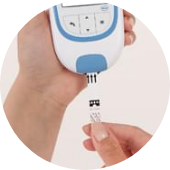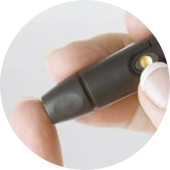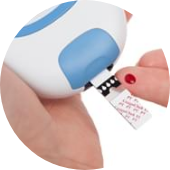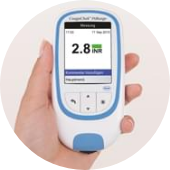Access coupon
Feel confident performing INR
self-testing
What you need to know about self-testing your coagulation levels with CoaguChek®.

Who is suited to INR self-testing?
Self-testing is suitable for patients on long-term (usually lifelong) anticoagulation with vitamin K antagonists (e.g., warfarin). If you have been prescribed a DOAC/NOAC, self-testing is not an option.
In order to become a self-tester, you need a certain amount of manual dexterity and practice. It is also possible for a family member or another caregiver to help you with this task.
The first step is to talk to your doctor about your interest in managing your coagulation levels yourself.
DOAC: direct oral anticoagulant; NOAC: new oral anticoagulant
How to talk to your doctor about self-testing
Don’t be shy about mentioning self-testing to your doctor. Explain how it would make your everyday life easier. For instance, you may consider blood tests from the vein stressful and feel restricted by the frequent doctor’s visits. Or perhaps you would like to be able to eat what you like again, but you also want to feel safe about it. There may be many reasons why you should become a self-tester.
If you decide to start self-testing, ask your doctor to provide you with a prescription for your CoaguChek® meter, which you can then obtain from your pharmacy.
How INR self-testing works
The term “self-testing” describes very precisely what it is. You become the manager of your coagulation testing and take charge of your own anticoagulation therapy.
With self-testing, you get information about your coagulation levels anywhere, anytime. As a bonus, you get to know your body better. You’ll gain insights into how you react to stress, changes in your diet, or changing climates. And if you’re ever uncertain about whether your coagulation value is on target, you can get peace of mind by simply doing an extra test.
Frequent INR testing can actually increase your time in range and lead to fewer life-threatening events.1,2
Self-testing with CoaguChek®, step by step
CoaguChek® is a portable coagulometer that requires just a single drop of blood and provides accurate and reliable INR results in less than one minute.

STEP 1:
Insert the test strip in the measuring device and confirm that the code chip matches the strip.

STEP 2:
After a warm-up phase, obtain a small drop of blood from the fingertip virtually painlessly with the CoaguChek® Softclix® lancet.

STEP 3:
Place the drop of blood on the test strip within 15 seconds.

STEP 4:
Your current coagulation level will be displayed after just one minute.
CoaguChek® INRange
Watch the short video below to learn more about how to use CoaguChek® INRange to determine your INR levels.
CoaguChek® XS
Watch the short video below to learn more about how to use CoaguChek® XS to determine your INR levels.

Do you have questions about self-testing?
The CoaguChek® Roche Care Centre is here to answer your questions.Call us toll-free at 1-877-426-2482 Monday to Friday between 8 a.m. and 5 p.m. (EST).
Get in touchPatient experiences
An instant result was just magic, absolute magic.
Katherine was born with a condition that affects her heart valves, so regular hospital visits are something she’s had to get used to. She and her mom explain how CoaguChek® has given her independence and the chance to live the life she’s always wanted.
See how self-testing with CoaguChek® can help you maintain your independence.
The freedom of self-testing
There are
options.
After an aortic valve replacement, Bob was placed on lifelong anticoagulant therapy. When he heard about self-testing, he was immediately interested. Self-testing has finally given this avid traveller the convenience and peace of mind he’s wanted.
I got to know my body
much better.
At 22 years old, Heike received an artificial heart valve and quickly learned how to live with it. However, she only started feeling independent and free once she was able to measure her coagulation level herself.
Read more
Do you have other questions about self-testing with CoaguChek®?
Visit our FAQ page for answers.
FAQs
References:
1. Bauman ME et al. EMPoWARed: Edmonton pediatric warfarin self-management study. Thromb Res. 2015;136(5):887–893.
2. Heneghan C et al. Self-monitoring of oral anticoagulation: systematic review and meta-analysis of individual patient data. Lancet. 2012;379:322–334.


